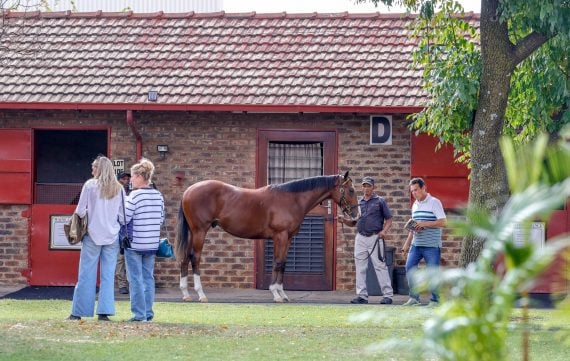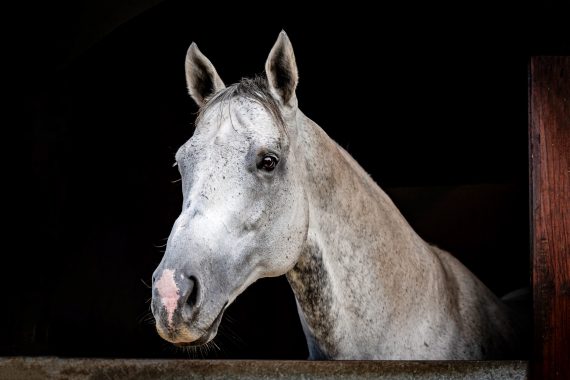Robin Bruss writes about the performance of SA mares At stud overseas.
As we learnt last week, a number of high class South African racemares were sent to race abroad during the first decade of the 2000’s and then in the second decade, this reduced to a trickle during the suspension of the EU protocol with the few exports enduring a long quarantine on the island of Mauritius, taking anything from 6 months to a year to arrive at their destination.
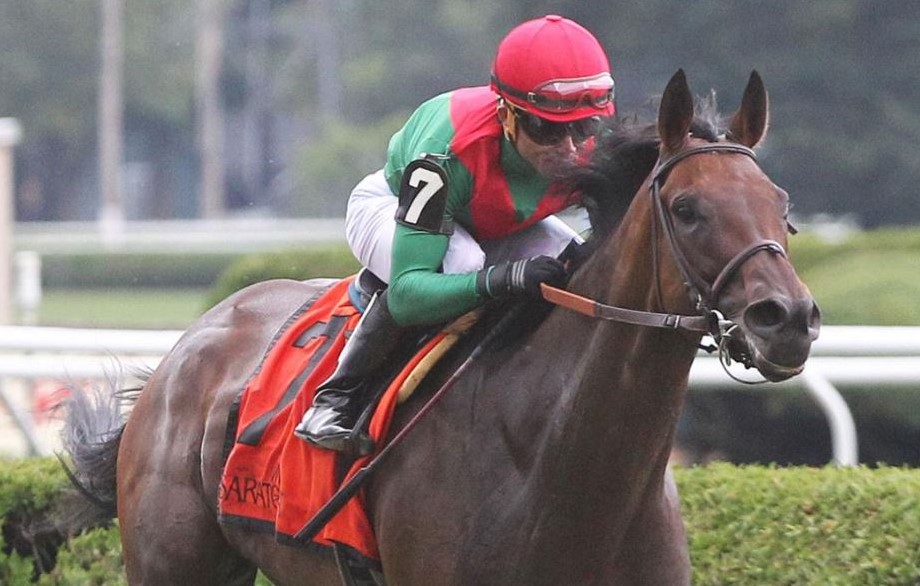
Oleksandra (Pic – Team Valor International)
The success rate of these exported mares at stud in other parts of the world has been very high – and greater than most breeders realise. Robin Bruss tells a fascinating story.
Protectionist policies
There was a time in the 1970s to 1990s when the TBA purposely constrained imports of fillies, believing that the local breeder would be detrimentally affected if owners imported stock to race against local horses. They also disliked Stakes Winners being exported, complaining that it was a loss to the gene pool in South Africa.
When the new South Africa arrived in 1994, so did a new Government policy: to abolish protectionism and for all industries to compete globally.
In horse racing, imports of foreign bred horses created a melting pot at home in which South African breds competed with proven horses from Europe and yearlings from Argentina, Chile, Brazil, as well as Australian and NZ breds.
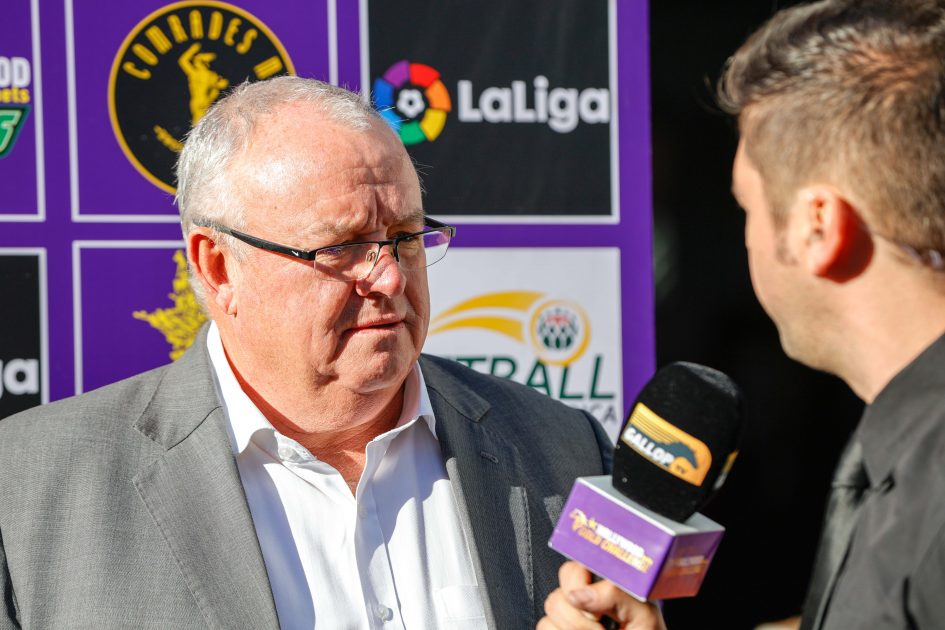
Mike de Kock (Pic – Candiese Lenferna)
Open Policy
It kept us up to a global standard and when we began campaigning South African-breds in the Middle East with Mike de Kock and further afield with Barry Irwin taking our horses across the world – we realized the benefit – that we were up to the mark.
An open policy is undoubtedly the best, but the introduction of incentives and better taxation regimes to encourage greater production and employment, plus the streamlining of movement controls and a global marketing campaign, also must play a part in expanding what we have – especially now when numbers are down.
The benefits of such an open policy have far outweighed any loss, firstly in the return of foreign income to the South African market, and secondly in the bloodlines that have come to South Africa to found families and create hybrid vigour that is found in the international outcross.
The story of Petrava
I will begin with an unusual story, slightly dated, but which expresses the principle of an open policy.
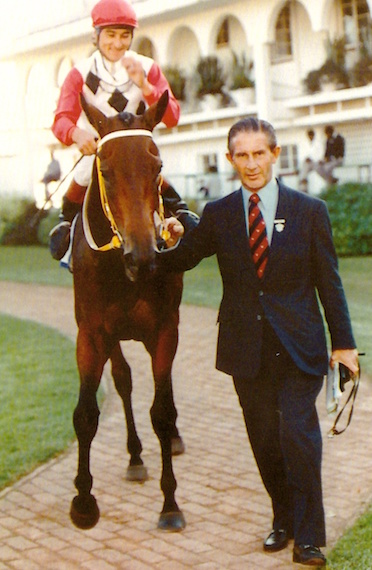
Laurie Jaffee
In 1985, the Late Laurie and Jean Jaffee raced a champion New Zealand bred filly in South Africa called PETRAVA, who David Payne trained to win 10 of her 15 starts including five Grade 1 events.
At the end of her career, Laurie and Jean Jaffee received an offer from Sheik Hamdan al Maktoum, said to be US$500,000 at the time: an offer too good to refuse and the filly was sold and exported to USA.
The Jaffees were stung to then be criticized in the media by the Chairman of the TBA of South Africa who stated that Petrava had been imported on a TBA permit (then, all yearling imports had to be approved by the TBA committee) and that the Jaffee’s application had stated as purpose of importation: “To improve the breed”.
“You have sold her” opined the Chair, “without giving local breeders the opportunity to buy her first! The affordability of the purchase price is not the point, the principle is that you made no attempt to improve the breed.”
Petrava didn’t race in America, but rather she was bred to the famous stallion Blushing Groom at Gainesway Farm in Kentucky and the resulting colt foal bred by Sheik Hamdan was sent to race in England.
Fast forward and a couple of years later, I happened to be at the Tattersalls Autumn Horses in Training Sale in UK and lo and behold, here was the colt by Blushing Groom out of Petrava, the produce of two champion parents, and was being sold at auction without reserve as a one time winner. He had won first time out by 5 lengths but then had a wind problem and had been hobdayed.
I called Mr Jaffee and suggested he buy the colt for South Africa as he surely would not be expensive. And so we did and secured him for the sum of 6,600 Guineas.
“Ah” Mr Jaffee said “Now I will tell the TBA that this will fulfil my intention to bring the blood of Petrava back to South Africa! And for good measure I will ask my pal Graham Beck of Highlands Farms Stud to go 50/50”.
In case you haven’t guessed already, the colt’s name was JALLAD (USA)!

Jallad, by Champion Blushing Groom from Champion Petrava, became Champion Sire (Pic – Supplied)
Jallad proceeded to win 8 races including the Durban Merchants Gr2, was placed in the Computaform Sprint Gr1 and then retired to stud at Highlands Farm.
He was an immediate success, became Champion 1st crop sire, and two years later was Champion Sire of South Africa.
He sired 60 SW (of which 17 were Gr1 Winners) they won 110 Stakes Races ranging from 1000m to 3200m, and they earned R125 million in stakes.
At stud his daughters have produced a further 65 SW and who have won over R200 million in stakes, and already produced another 10 individual Gr1 Winners. More than 120 SW descend from Jallad.
Laurie Jaffee had made good on his promise – the influence of Petrava through her son Jallad has reached every corner of the racing world in South Africa and beyond, and has benefitted the Stud Book to a far greater extent than had she become a broodmare at home in South Africa and produced a handful of foals.
The Jaffees kindly gave me a free service to Jallad, and I sent a mare – and the foal turned out to be Zebra Crossing, who won the J&B Met Gr1. I also bought a Jallad mare and she produced Will Pays, the 2018 Equus Champion Sprinter and Gr1 winner. When a story becomes good, it’s good for everybody!
The Story of National Colour
Altus Joubert of Riethuiskraal Stud bred the grey mare National Colour (2002) by National Assembly (USA) from the 1200m Milnerton Champagne S. winner Rainbow Cake.
Racing for Chris Van Niekirk and trained by Sean Tarry, National Colour had the type of pure speed brilliance that reserved for 1000m sprinters. She won three Gr1 races and thrashed the colts in the 1000m Computaform Sprint Gr1 and the 1200m Mercury Sprint Gr1 as a 3 year old to become SA Horse of the Year 2006.
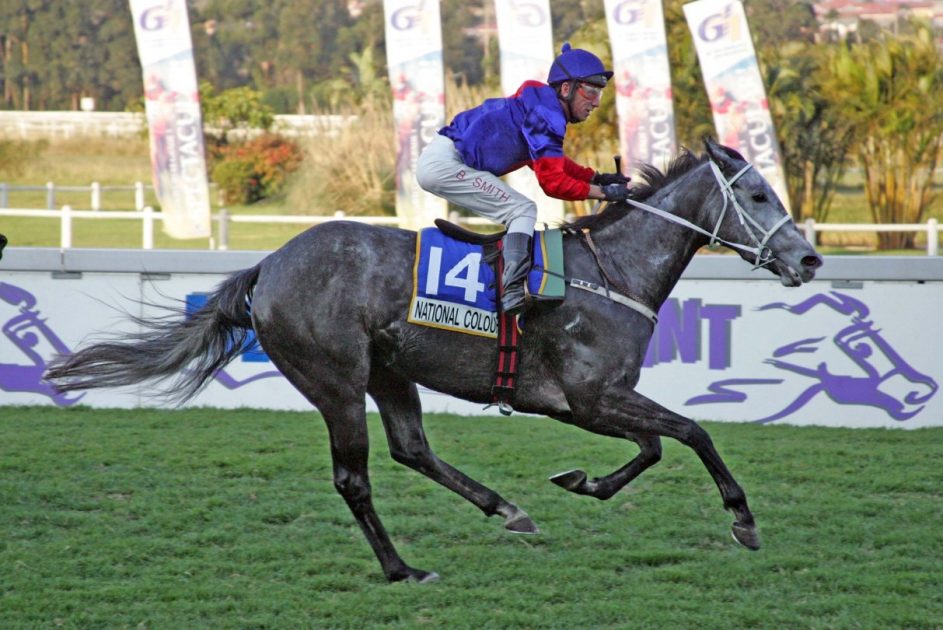
National Colour wins the 2006 Mercury Sprint Gr.1 (1200m) at Clairwood (Pic – Supplied)
Sent to Dubai, National Colour won there and then to England, she earned the title of Champion Female Sprinter in Great Britain 2007 when she was gallant in losing by a nose to a colt in the Nunthorpe S (Gr1), effectively the 5f sprint Championship of England. Timeform rated her 120.
Exported to Australia for stud, she was lost to South African breeding, or so we thought! But like Petrava, her influence has spread far and wide and more than anyone thought possible.
In Australia she was bred to the Golden Slipper Gr1 winner Sebring and produced a filly Circle of Speed, who came to race and breed in South Africa and has already produced the Gr3 SW Full Velocity, founding a South African branch of the family. She also has a yearling filly by What a Winter entered on the NYS on April 18th in the Riethuiskraal draft.
National Colour then produced two colts both by Australia’s Champion Sire Redoute’s Choice, RAFEEF (an A$800,000 Yrlg) and MUSTAQUEEM (an A$1,75 million Yrlg), both bought by Sheik Hamdan for Mike de Kock to race in South Africa.
Memorably on the same day at Turffontein, both won Gr1 races – Mustaqueem won the SA Nursery Gr1 and Rafeef won the Computaform Sprint Gr1.
Rafeef, Gr1 Winning product of two champion parents, retired to Ridgemont Highlands Stud and has become a high class stallion. In his first 3 crops racing he already has 18 SW (six more than Jallad at the same stage) and has astounding versatility: in his first crop he sired the Computaform Sprint Gr1 winner (1000m) Master Archie, as well as the SA Derby Gr1 winner (2450m) Aragosta. His influence on South African breeding, like Jallad, is going to be profound.
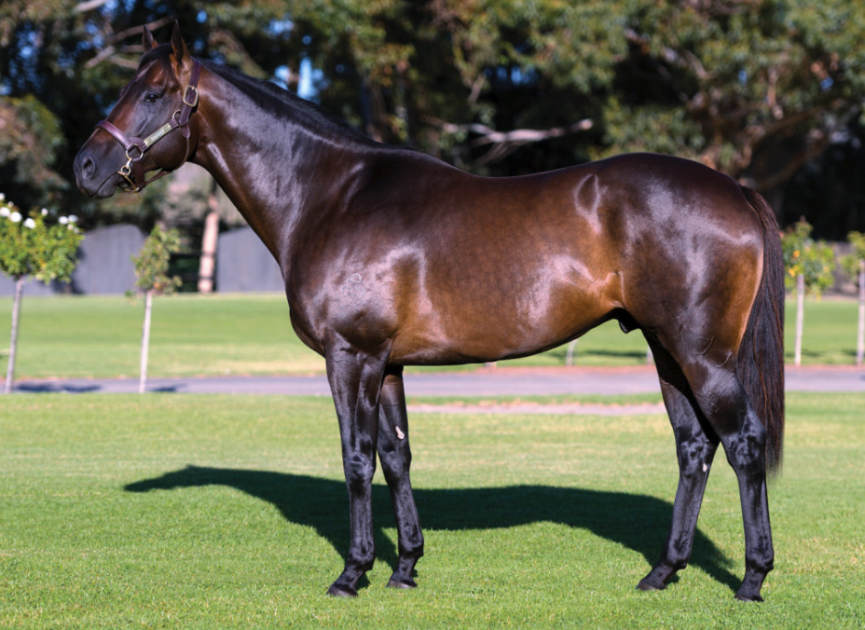
Rafeef (Aus) b.h. by Redoutes Choice – National Colour at Ridgemont Highlands (Pic – Supplied)
His Gr1 Winning full brother Mustaqueem was sold to Chile in South America for stud and his first crop are now yearlings and are very well received.
National Colour’s blood now stretches across the whole of the Southern Hemiphere.
She produced 8 foals in Australia. Seven went to auction and they grossed A$4,960,000 (which converts to R60,4 million at the current exchange rate).
One of her daughters, the grey Sarraqa (by the Golden Slipper winner Snitzel) made A$675,000 (R8,25m) as a yearling, and never got to the races, but her first foal is a grey colt, by the High Chapparal stallion Dundeel. Speed mated to some stamina. The colt is a current 3 year old and named CELESTIAL LEGEND (AUS).
His 86 year old Hall of Fame trainer Les Bridge proclaims Celestial Legend to be the best horse he has had in 60 years. Celestial Legend won the 2024 Australian Guineas (Gr1) last month at Royal Randwick in Sydney, he has a host of engagements in Group 1 races in the Autumn Carnival, and he might well be the best 3 year old in Australia.
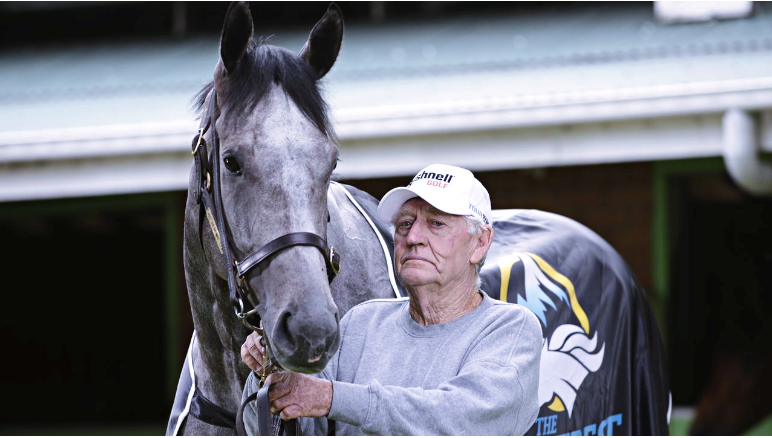
The 2024 Australian Guineas Gr1 Winner Celestial Legend (Aus), grandson of National Colour (SAF), with his trainer Les Bridge (Pic – Supplied)
VIA AFRICA (SAF) – The Gr1 Flying Machine by VAR (USA)
Via Africa was owned and bred by Mr G A Hauptfleisch and won 10 races at 1000m-1200m incl. the Cape Flying Championship Gr1 and the SA Fillies Sprint Gr1 twice. She would have won the Computaform Sprint Gr1 but was unlucky to meet the superstar colt What a Winter.
Sold to Newgate Farm in Australia, Via Africa’s second foal was IN THE CONGO (2018, by the Golden Slipper winner Snitzel), an A$350,000 yearling bought by the China Horse Club who proceeded to become one of the fastest horses of his generation. He blitzed them, start to finish to win the A$1million Golden Rose Stakes Gr1, the three year old version of the Slipper, defeating five other Gr1 Winners in race record time, and earning A$1,769,000 (R21,6 million). Retired to Newgate, his stud fee is A$33,000 (R400,000) and he covered more than 100 mares in his first season in 2023.
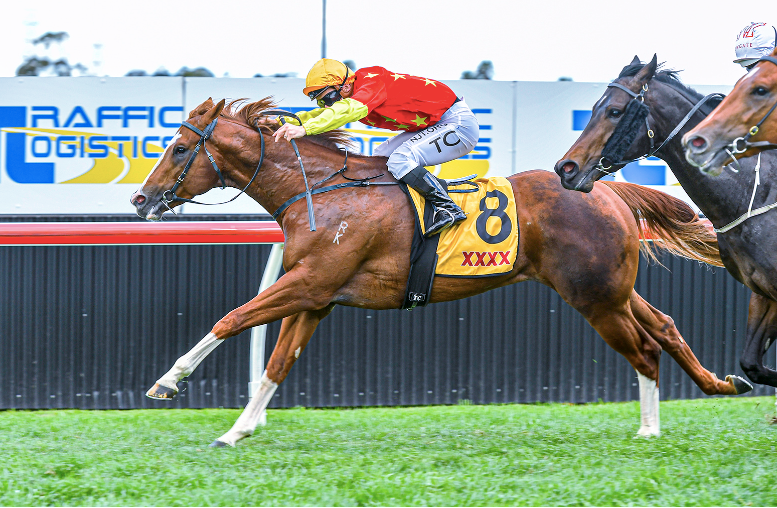
In the Congo, son of VIA AFRICA (SAF), by Var, wins the Gr1 Golden Rose S ($1million) in Sydney (Pic – Supplied)
Last year, a yearling daughter of Via Africa (SAF) made the top priced yearling at the William Inglis Sydney Easter Sale, selling for A$1,8 million (R22 million) to the bid of Arrowfield Stud.
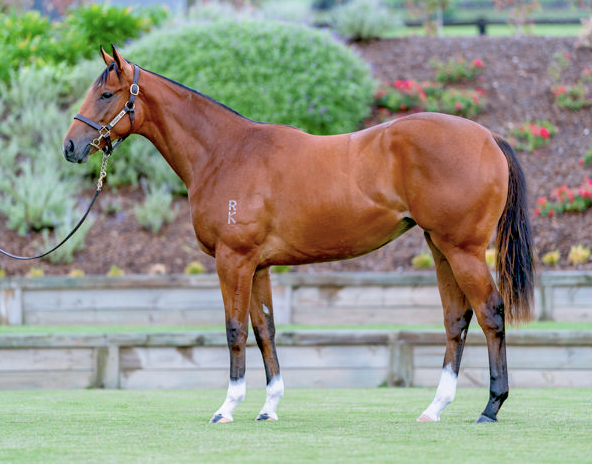
Yearling daughter of The Autum Sun – Via Africa (SAF) who topped the Sydney Easter (Pic – Supplied)
KOURNIKOVA (by Sportsworld)
Winner of the Fillies Guineas Gr1, Kournikova was sold to Airlie Stud in Ireland, and for them she produced 7 runners, 6 winners, amongst them three SW. Almost 50% of her runners were Stakes Winners in Ireland, GB and EU.
One of them, PEARL OF AFRICA, won two Listed stakes, then placed in several Gr2 events and now is breeding in Japan.
PERFECT PROMISE (by Caesour)
A Gr1 winner in South Africa, Perfect Promise won the CF Orr S (Gr1) (WFA) defeating colts in Australia. She has produced 4 winners so far including the Gr3 SW MORE ENERGY ($316,800).
BATTLE MAIDEN (by Goldkeeper)
Bred in Zimbabwe, Battle Maiden won the Garden Province S. Gr.1 before being sold to Australia. She produced 3 runners, 3 winners, and is grandam of LIM’S CRUISER, the Champion Sprinter of Singapore, 10 wins inc the Lion City Cup Gr1 twice and S$2,148,000 (R29,8 million).
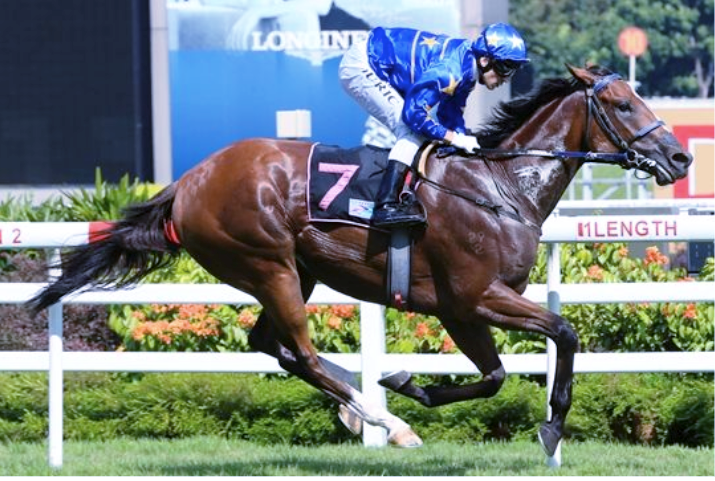
Lim’s Cruiser, grandson of BATTLE MAIDEN (Zim), was twice Champion Sprinter of Singapore (Pic – Supplied)
GEORDOBA (by Cordoba)
Winner of 10 races from 800m to 1000m, incl. the Henry Eatwell S (Gr3) and 4th in the Computaform Sprint (Gr1), the brilliantly fast Geordoba was as tough as nails in the Buddy Maroun yard. She has produced 8 runners, 6 winners in Australia, amongst them the New Zealand SW KHEMOSABI and she is the grandam of SHE’S ALL CLASS, who won the 2023 A$1 million Magic Millions 2YO Classic.
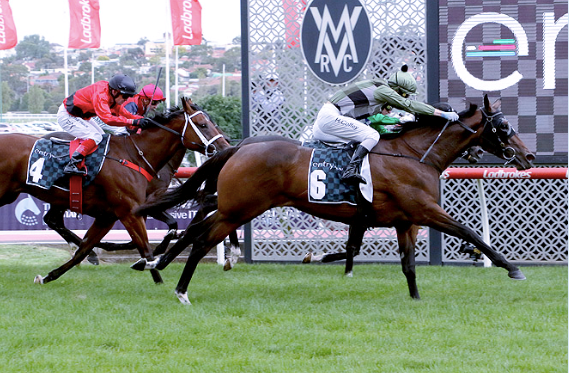
She’s All Classic, granddaughter of GEORDOBA (SAF), wins the $1m Magic Millions 2YO Classic 2023 (Pic – Supplied)
COVER LOOK (by Fort Wood)
Exported to Newsells Park Stud in England after winning the SA Fillies Classic (then Gr2), Cover Look’s first foal in UK was the SW SHIPMASTER, who won the Sagaro S (Gr3) at Ascot.
CARRY ON ALICE (by Captain Al)
One of the greatest sprinting mares in South Africa, the John Koster Klawervlei bred Champion Carry On Alice won 11 races inc five Gr1 sprint championship races in 2017.
It took a year to get her to Australia, and her career has just begun.
Fittingly, her first foal, an unraced colt by Golden Slipper winner and Champion Sire Snitzel, was named Koster and made A$700,000 at the Sydney Easter Sales.
The second foal made A$400,000 and won twice this season as a 3 year old and Stakes placed so far. The third, another Snitzel colt, was such a magnificent looker that he sold for A$1 million to the bid of the China Horse Club last year and now is a 2 year old named Manos, yet to race.
Carry on Alice has a yearling filly by Snitzel in the Sydney Easter Sale on 7th April, 2024.
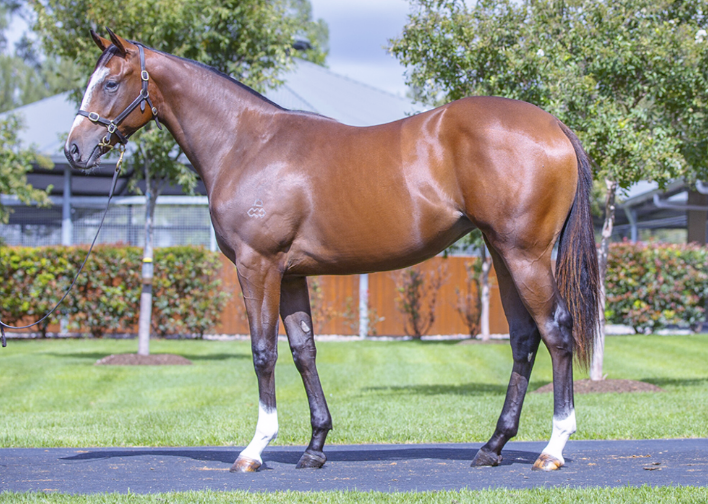
Carry on Alice (SAF)’s yearling filly by Champion Sire Snitzel going to Sydney Easter Sale on 7th April 2024 (Pic – Supplied)
The Team Valor mares
Barry Irwins’ Team Valor had significant success with South African fillies in Gr1 contests around the world. Here is a summary of stud successes –
1. IRRIDENCENCE (by Caesour)
Triple Gr1 winning heroine of the HK Queen Elizabeth S Gr1, has had 6 foals to race, three of them are winners and one of them is now a breeding stallion in Russia! Her most important progeny is the 2023 Stakes Winner HOPPER (Declaration of War), who won the Santa Anita Affirmed S (Gr3) and Oaklawn Mile (Gr3), and was 4th in Santa Anita (Gr1) and earned $419,000 so far.
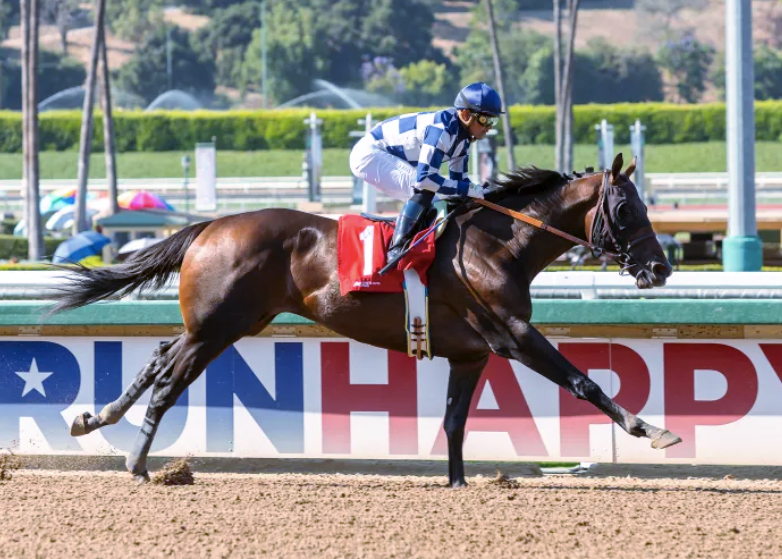
Hopper, son of Irridescence (SAF) wins the Affirmed S (Gr3) at Santa Anita by 5 lengths (Pic – Benoit)
2. SECRET HEART (by Fort Wood)
Winner of the Prix de Cap and four times Gr1 placed, Secret Heart was bred to the champion sire More Than Ready and produced a black colt which Barry Irwin named PLUCK, her first foal. Pluck won the 2010 Breeders Cup Juvenile Turf (Gr1) in the Team Valor silks.
The mare also produced THREE HEARTS (a filly by Hat Trick (JPN), who was a Gr3 Stakes Winner in California and sold for $650,000 at Keeneland mare sales.
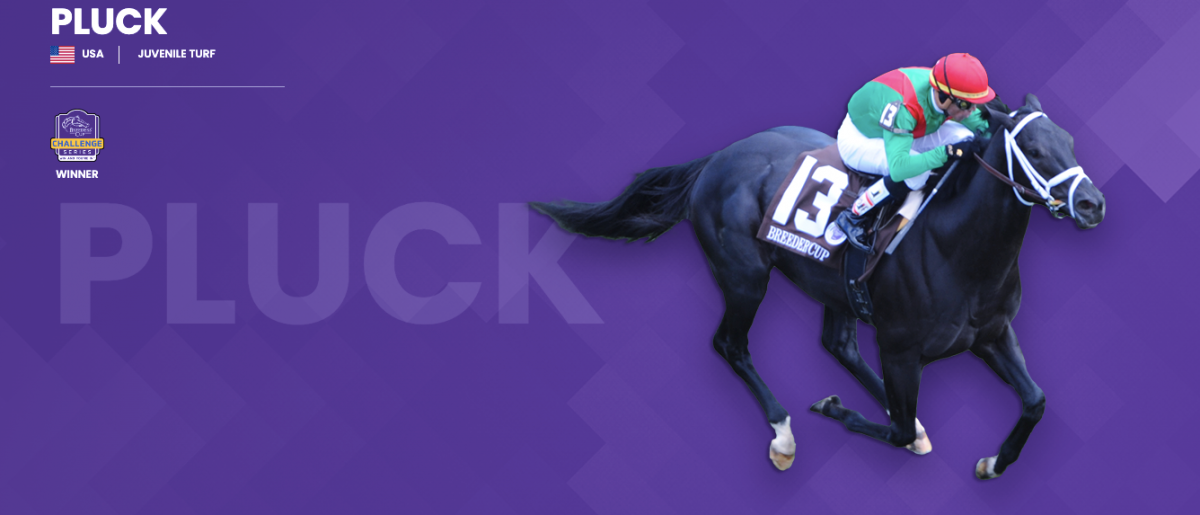
Pluck, son of Secret Heart (SAF), wins the Breeders Cup Juvenile S (Pic – Supplied)
3. SALLY BOWLES (by London News)
Winner of the KZN Guineas, Gr2, Sally Bowles sold for $160,000 at the Keeneland November Mares Sales. She has done well producing 6 winners including two Gr3 winners, LADY RADLER (in 2023) and CONSUMER CREDIT (Gr3 Winner and 3rd American Oaks Gr1).
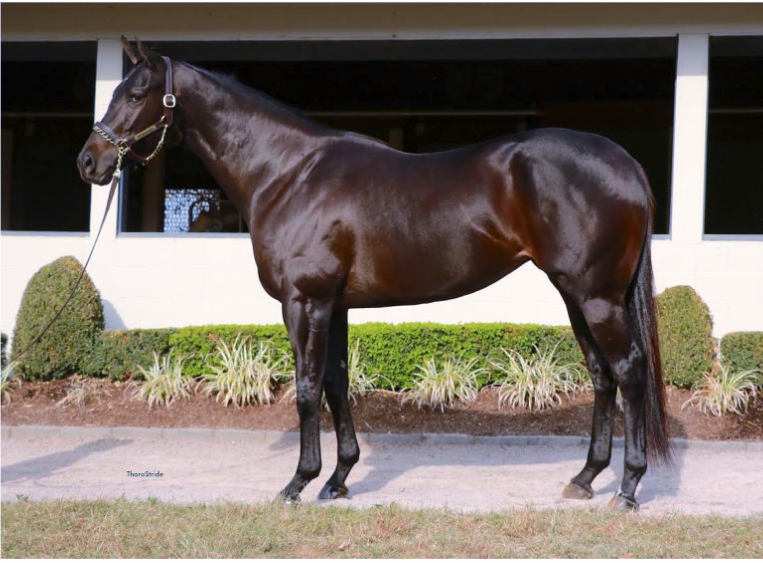
Consumer Credit (USA), Gr1 placed daughter of Sally Bowles (SAF) made $700,000 at The Keeneland November Mare Sale (Pic – Supplied)
4. WARNING ZONE (by Elliodor)
Champion 2 year old in 2003, Warning Zone won the Golden Slipper (Gr2) and twice Gr1 placed.
In USA she became a Stakes Winner before being sold to Australia at the Keeneland Sale for stud.
To the mating of Street Cry, she produced PITTSBURGH FLYER (Gr3 Winner and Gr1 placed).
In turn Pittsburg Flyer went to stud and produced the grand racemare SEPTEMBER RUN (6 wins, and $2,492,625 incl The Coolmore Stud S (Gr1) and the William Reed S (Gr1) and ran 7 Gr1 places to rank amongst the best fillies of her generation. She is the latest SW from the famous Drohsky female line that has lasted in the Birch Bros dynasty for more than 100 years.
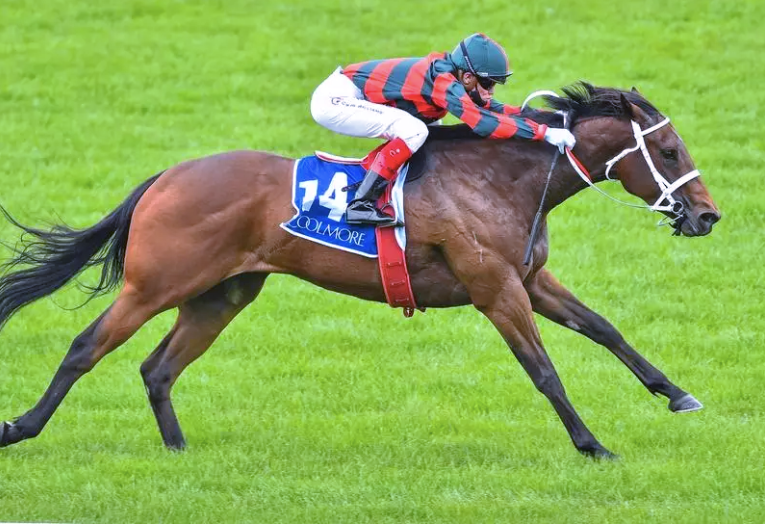
September Run (Aus), granddaughter of Warning Zone (SAF), dual Gr1 Winner in Australia (Pic – Supplied)
5. ALEXANDRA ROSE (by Caesour)
Winner of the Golden Slipper Gr2 in South Africa, Alexandra Rose won the Monrovia S (Gr3) at Santa Anita in California for Team Valor.
She has produced 6 winners in Australia, including a filly named OLEKSANDRA (2014 by Animal Kingdom) who has won 8 races and $693,694 and became the first Australian bred to win a turf Gr1 event in USA when she won the Jaipur S. (Gr1) over 7f at Belmont Park defeating the colts.
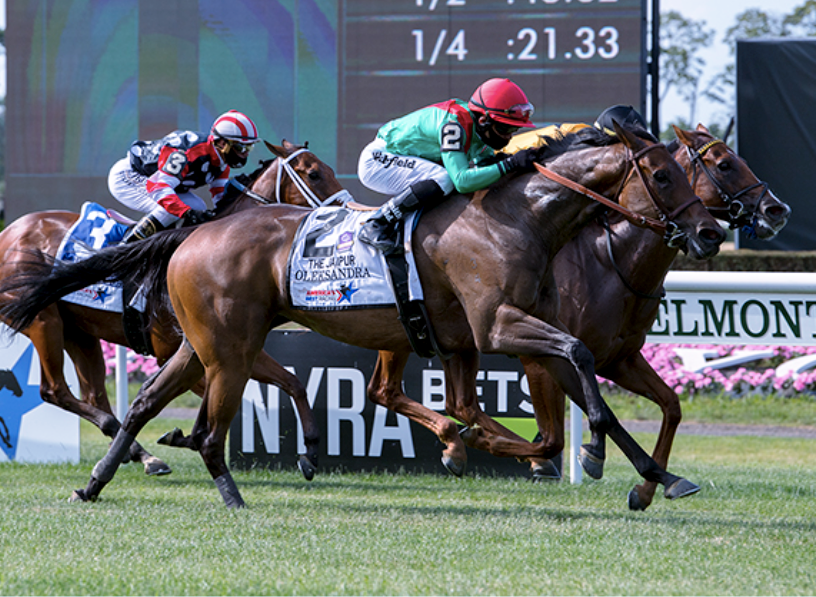
Oleksandra (Aus), daughter of Alexandra Rose (SAF) wins the Jaipur S (Gr1) in New York (Pic – Supplied)
TRACY’S ELEMENT (AUS) and SYDNEY’S DREAM (AUS)
We can’t leave the story without mention of two Aussie bred fillies that raced in South Africa and returned to stud in Australia to not only advertise the value of Gr1 racing form in South Africa, but also to leave an indelible mark on the stud book in Australia.
Both were bought in the 1990s when Australian breeding was largely bankrupt and breeders were in a terrible state.
To try and save the day and overcome the inaction of their TBA, the major farms formed a new organization the CTBA, the Commercial Thoroughbred Breeders Association, put together a pot of cash and invited and paid for a group of 14 South Africans to attend the select Sydney Easter Yearling Sales, where the average price was A$35,000 (then converted to R70,000) and shipping cost home was R25,000. The good old days before Australian breeding became the powerhouse it is today.
Ormonde Ferraris bought Tracy’s Element (Last Tycoon) for A$70,000 and I was the buyer of Sydneys Dream (by champion sire Bletchingly), who topped the sale at A$200,000.
Tracy won four Gr1 races in South Africa and Sydneys Dream won the Allan Robertson Fillies Championship Gr1.
At stud Tracy has been a goldmine, producing 10 runners, 9 winners including Horse of the Year TYPHOON TRACY (11 wins, $2,438,000 and 6 Gr1 wins). She is also grandam of ALLIGATOR BLOOD
(13 wins, five Gr1 wins and $6,2 million and still racing).
Sydneys Dream produced CHARGE FORWARD (winner of the Galaxy S Gr1, 1000m championship, and who became a stallion at Arrowfield Stud, siring 359 winners incl 28 Stakes Wins and $33 million).

CONCLUSION
This is the world of international breeding and one which South Africa, as the 8th largest racing country, needs to be fully engaged in, not just for the benefits of trade in which we should enjoy a huge advantage given that the $/R exchange rate and our domestic bubble make our horses the best value of any country in the world, but also because we have a very long history of thoroughbred breeding.
It was in 1907 that South African bred Camp Fire won the Kings Stand Stakes at Royal Ascot.
We are overdue to repeat that success!







